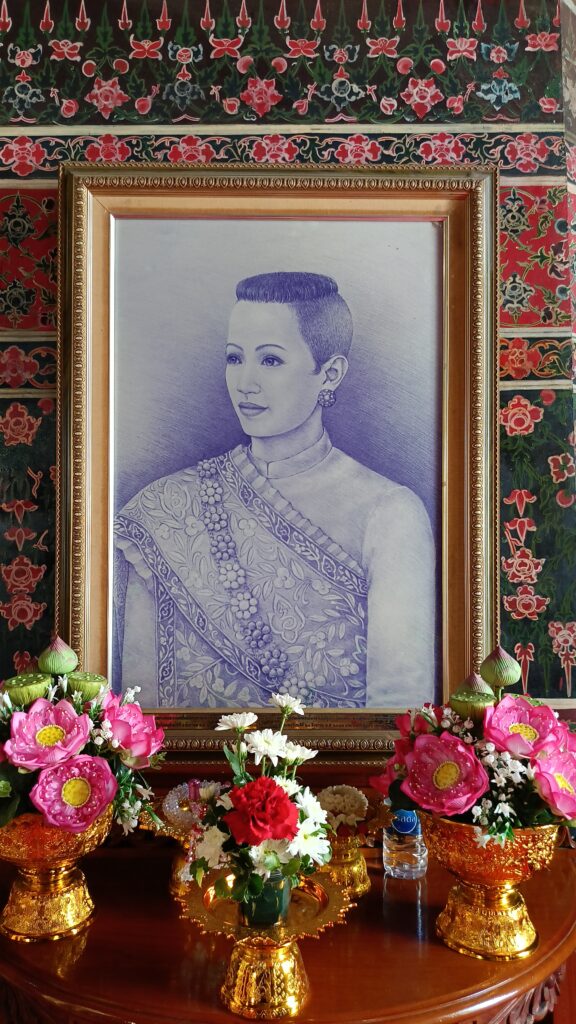Today, Nai Mu, the spiritual guide from God’s City Column at Ticy City, invites us on a journey to the serene and historic Wat Thep Thidaram Worawihan. This sacred site offers visitors the chance to honor Princess Wilat (Phra Ong Chao Wilat) and explore the former residence of Thailand’s legendary poet, Sunthorn Phu.

This visit coincides with the airing of Mom Ped Sawan, a Thai PBS drama showcasing every Friday, Saturday, and Sunday at 8:30 PM. The story delves into the lives of Mom Sud and Mom Kham, two real historical figures and royal consorts during the reign of King Rama III. Their unique relationship, set against the backdrop of royal court life, resonates with the temple’s deeper connections to feminine strength and resilience.
A Temple Built for Women, Rooted in History
Unlike the bustling atmosphere of many other temples, Wat Thep Thidaram is a peaceful retreat steeped in women’s history. Commissioned by King Rama III between 1836-1839, the temple was originally known as “Wat Phraya Krai Suan Luang” before being renamed. It was built as a royal gift for his eldest daughter, Princess Wilat, who played a pivotal role in the inner court’s administration and cultural development.
Who Was Princess Wilat?
Born on December 5, 1811, and passing on August 21, 1845, Princess Wilat (later titled Prince Apsorn Sudathep) was a remarkable figure. She was not only a key administrative leader in the royal palace but also a patron of the arts, particularly literature and poetry. Known for her intelligence, modern outlook, and compassion, she supported prominent poets of the era, including Sunthorn Phu and the female poet Khun Suwan, leaving an indelible mark on Thailand’s cultural heritage.
The Poets of Princess Wilat
Khun Suwan: Known for her distinctive style, she authored works such as Phra Male The Thaitai, a satirical poem, and Anurut Roi Rueang, a collection weaving 51 classic tales into a single narrative. Her Long Song of Mom Ped Sawan offers a rare glimpse into court life and early depictions of same-sex relationships among women.
Sunthorn Phu: Thailand’s celebrated “commoner poet” and a UNESCO-recognized figure, Sunthorn Phu penned masterpieces like Nirat Muang Klaeng and Phra Aphai Mani. During his second monkhood, he resided at Wat Thep Thidaram, where his former quarters now house a museum dedicated to his legacy.
What to See at Wat Thep Thidaram
Royal Portraits: Admire the regal depictions of King Rama III and Princess Wilat displayed in the ordination hall and viharn.
Phra Buddha Thewa Vilat (Luang Pho Khao): This exquisite white marble Buddha, originally housed in the Grand Palace, now resides in the ordination hall atop a magnificent pedestal.
Sunthorn Phu Museum: Discover the poet’s life and works through themed rooms, such as the Endless Inspiration Room and the Under the Yellow Robe Room.
Statues of 52 Bhikkhunis: Life-like sculptures of female monks in various postures—praying, meditating, and engaging in daily activities—bring the temple’s spiritual legacy to life.
Intricate Stone Reliefs: Marvel at detailed carvings of Thai and Chinese women, a testament to the artistic brilliance of the era.
A Sacred Space for Women’s Empowerment
As Nai Mu highlights, Wat Thep Thidaram holds a profound connection to women. It’s a place where women—be they lay visitors or bhikkhunis—can pay respects, seek blessings, and cultivate inner strength. Whether you’re drawn by its tranquil beauty or rich history, this temple invites you to embrace its empowering energy.
Discover the stories, honor the past, and find inspiration at Wat Thep Thidaram Worawihan—a sanctuary of grace, resilience, and cultural heritage.